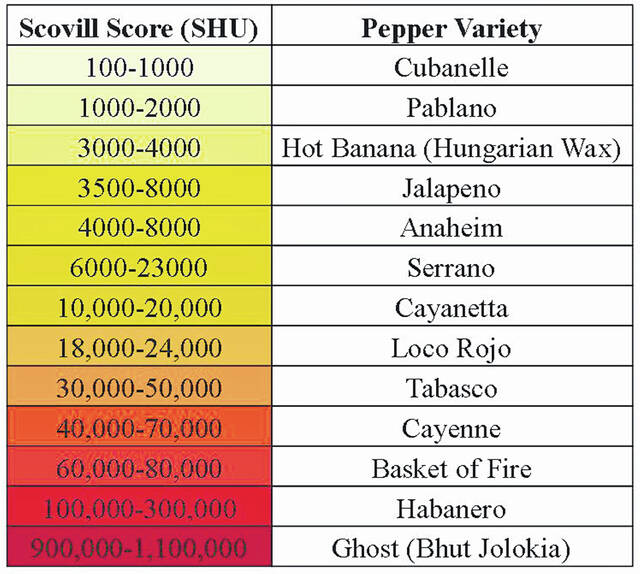

Whether you’re serious about hot peppers or just enjoy a little “heat” with your food, growing hot peppers in your vegetable garden is fun and rewarding. Peppers are a warm-weather crop, so the best time to plant them is early May, after any danger of frost is past.
Hot pepper fans have more varieties than ever to choose from these days, and there’s more than a little hype surrounding this topic. Comparing the relative potency of hot peppers is a favorite, not to say macho, pastime. To make comparison easier, peppers are scored in Scovill Heat Units, or SHU’s. Named after its creator, American pharmacist Wilbur Scovill, this measuring system rates the capsaicin content of peppers using the Scoville Organoleptic Test.
Test results vary widely, since human tasters are involved. In addition, pepper potency depends somewhat on growing conditions. Still, the Scovill scale is a useful means of comparison.
There are hundreds of known varieties available today, and it can be hard to tell the difference between them at times. Here’s a “short list” of popular hot pepper varieties, from mildest to hottest:
Cubanelle: Mildly hot pepper traditionally used as a roasting and stuffing pepper. 100-1,000shu.
Pablano: Mildly hot pepper with spicy bite. Commonly used to make chili powder and salsa. Also good for grilling and stuffing. 1,000-2,000shu.
Hot Banana: Also called Hungarian Wax. Canary yellow fruits turn bright red when fully ripe. Great for pickling and drying. 3,000-4,000shu.
Jalapeno: Dark green fruits are at their hottest when they are allowed to fully ripen to red. 3,500-8,000shu.
Anaheim: Mildly hot chili pepper. Plants produce loads of long green fruit that turn brilliant red when fully ripe. 4000-8,000 shu.
Serrano: Very hot and pungent pepper with a distinct flavor! Five times hotter than Jalapenos. 6,000-23,000shu.
Cayanetta: Compact habit ideal for containers, windowsills and garden borders. Doesn’t need staking. Abundant bright red 4 inch fruit. Cold & Heat tolerant. 10,000-20000shu.
Loco Rojo: Compact attractive habit. Loads of 2inch upright facing purple peppers turn green to bright red. Pungent, similar to a cayenne type. 24,000shu.
Tabasco: The pepper used to make the world famous sauce. Pick when red for the spiciest flavor. 30,000-50,000shu.
Cayenne: High yielding hot pepper ripens from dark green to intense red. Bold flavor and medium heat. 75 days, 40,000-70,000shu.
Basket of Fire: Compact Chili for hanging baskets and containers. Heavy crop of 2-3inch creamy colored peppers turns yellow, then orange, then bright red. 80,000shu.
Habanero: Not for the faint of heart. Just one pepper adds spicy heat to an entire dish. Dries and freezes well. 100,000-300,000shu.
Ghost: Legendary variety known as one of the hottest peppers in the world. Also known as Bhut Jolokia. 900,000-1,100,000shu.
The potency of hot peppers can be compared using the Scovill scale.
Steve Boehme is a landscape designer/installer specializing in landscape “makeovers”. “Let’s Grow” is published weekly; column archives are on the “Garden Advice” page at www.goodseedfarm.com. For more information is available at www.goodseedfarm.com or call GoodSeed Farm Landscapes at (937) 587-7021.



